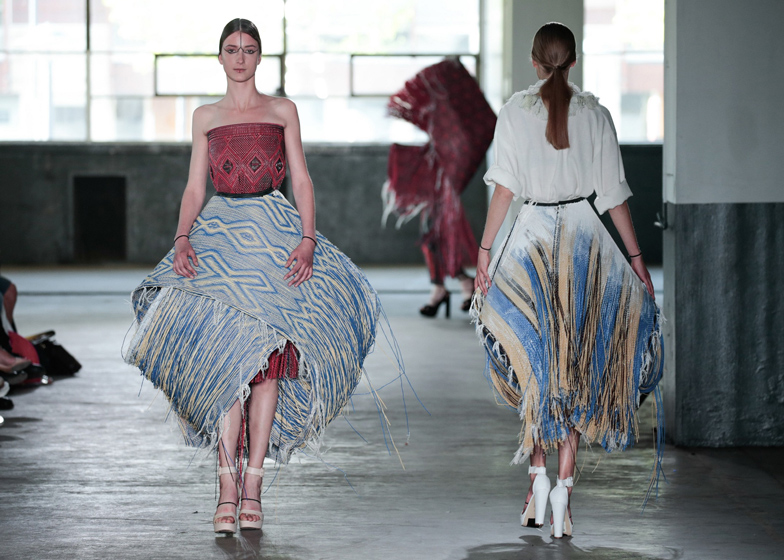Amsterdam fashion designer Karim Adduchi has paid tribute to his Berber heritage by adapting traditional carpets into frayed and patterned garments.
Adduchi sourced materials from his home country of Morocco to create his collection, which is titled She Knows Why the Caged Bird Sings.
The designer is of Berber descent – the group is indigenous to North Africa and is known internationally for its textile craftsmanship.
"My intention with this collection was to pay homage to my culture 100 per cent," he told Dezeen. "Part of that was to bring the materials originally made by the tribes where I come from."
Carpets, wool and leather – all associated with Moroccan craft – have been incorporated into the garments. Traditional Berber carpets date back to prehistoric times and were made by knotting natural fibres, while some contemporary industrial versions are woven from wool, nylon and plastic.
With his collection, Adduchi aimed to tell the story of Berber women like his mother and grandmother, who are often reclusive.
"I found it inspiring how these women find power in hiding, opposite to the western culture where exposing yourself is a sign of power," he said. "In the end it is easier to show than to hide, and there is respect and courage in still being beautiful with the mystery that comes from their own decision."
Translated into clothing, the frayed edges of a black and red cape rise up around the head and partially cover the face.
In a more extreme example, a cream and black striped jacket envelops the uppers arms, shoulders and head, with the wearer's identity obscured by the threads that meet down the middle of the front.
"The collection was a process of translating the symbolism and perception of these women, to give them a voice," he said. "It takes time and knowledge to unravel these women's looks."
Fibrous strands are curved and looped into structured skirts, while softer materials are draped to create oversized headdresses.
Woollen tassels are used to decorate necklines and shoulders of light-coloured loose shirts and dresses.
"I tried to show the duality of every material, creating the feeling of strength and fragility – the same duality that women have," Adduchi added.
The designer moved to Amsterdam in 2010 to study fashion at the Gerrit Rietveld Academie, from which he graduated last year, and has continued to work in the city.
"The fashion scene in Amsterdam is mostly influenced by the big fashion capitals," said Adduchi. "But it is growing, and that makes it exciting because there is more chance of creating new styles, but the same chance of making a mistake."
The Dutch capital is also the base for established fashion house Viktor & Rolf, which presented wearable paintings during its most recent haute-couture show. Other emerging fashion designers in the Netherlands include Martijn van Strien, who launched his own label with a collection of laser-cut garments in 2014.
Adduchi's work will be displayed at the WOW Amsterdam hostel from 5 to 29 November.
Photography is by Team Peter Stigter, unless specified otherwise.

